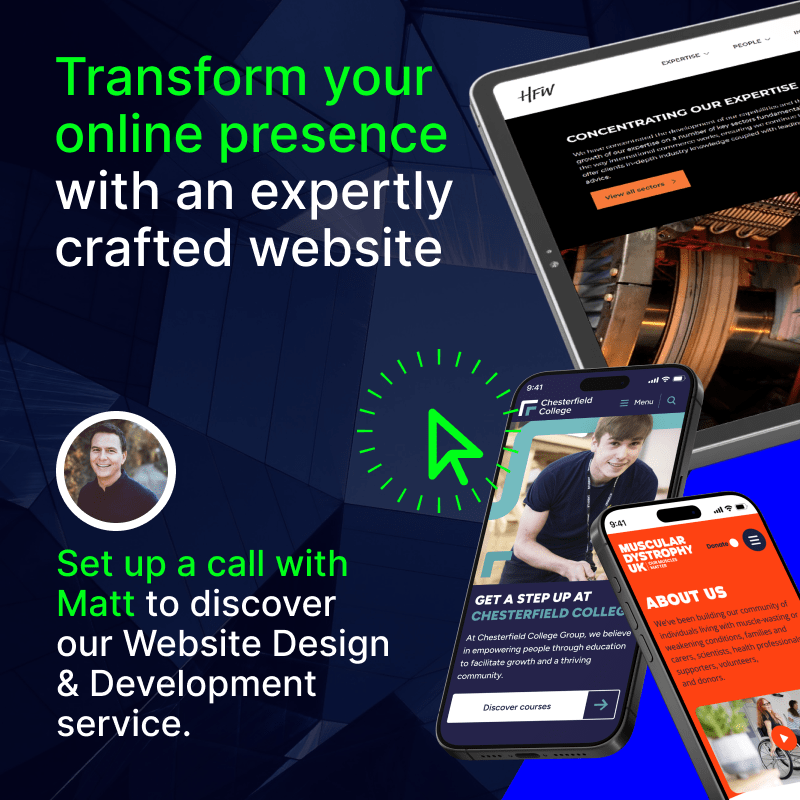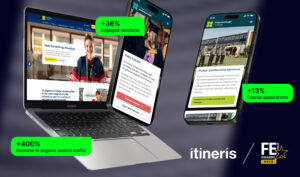Education Website Design Guide: Examples, Tips and Considerations
Whether it’s for a school, a college or a university, a solid online presence is critical.
This goes far beyond a website that simply provides the basic details and puts your brand online. Your audience doesn’t just want to discover your institution – they want to fully engage with it. So, you need a deep digital presence that applies education website design best practices.
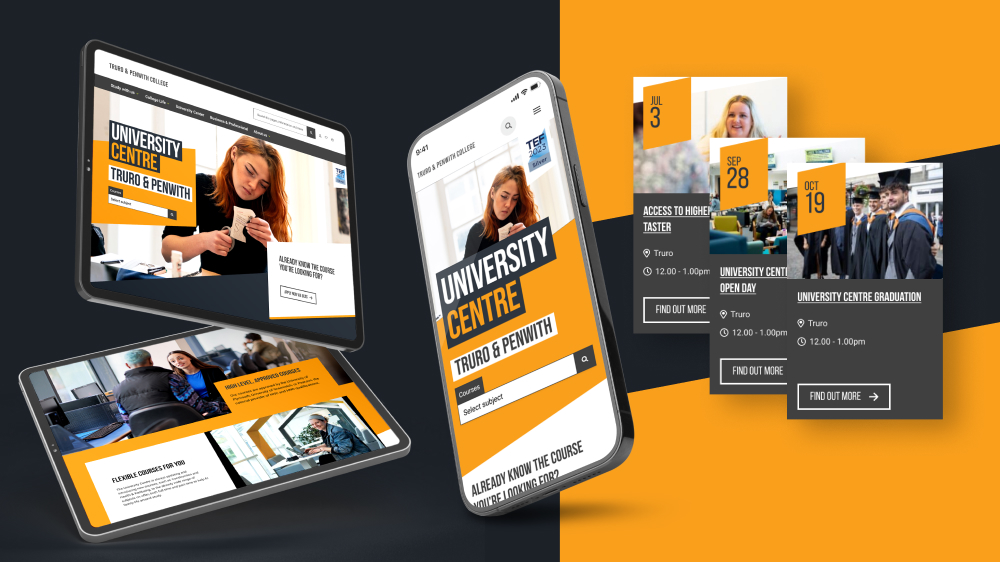
Luke is the Lead Designer at Itineris, specialising in creating compelling digital experiences that blend creativity with strategy. With a strong focus on lead conversions, he crafts user-centric designs that not only captivate but also drive results. His keen eye for detail and passion for innovation ensure brands stand out through engaging visuals and seamless interactions.
Education website design is unique. It has unique challenges and it addresses unique audience segments.
With an increasingly competitive online and eLearning space, having a strong website is more important than ever before. It requires the right blend of design aesthetics, user experience considerations and technical performance all wrapped into one.
From our experience as the leading education website design team in the UK, here’s what you need to know about how to get this right.
What Education Website Design Needs to Achieve
Every industry has unique needs from its websites, and university and college websites are no different.
These websites need to do so much more than simply look good and attract traffic. They need to engage prospective students, support current ones and serve faculty and staff effectively.
Education websites typically need to appeal to a broad and diverse target audience sector, including school leavers, parents and potential employers. This involves providing the information needed to generate student interest, have the digital infrastructure to sell courses, and outline the college details beyond course offerings.
Well, all this and a whole lot more.
So, a well-designed education website should balance aesthetics, usability and functionality to meet these needs. Here are the first necessary steps to do this.
Provide a Seamless User Experience
When designing an effective website, you need to put your users first.
Just because a website template might look good, it doesn’t mean your actual users will respond to it in a positive way.
Any education website must be easy to navigate for diverse users. Clear menus, logical content structure and a robust search function help visitors find information quickly. Mobile responsiveness is also essential, as around half of students access sites via smartphones.
This is only scratching the surface though, as these rules apply to any website.
As an education provider, you need to ensure your site provides an ideal experience for your specific user base. You can only really achieve this through actively collecting data insights and taking an iterative approach to web design.
Understand how users navigate your site, how they engage with key pages, where they get stuck and where they convert. By consistently monitoring these elements, you’ll be able to design and develop a website that provides the most enjoyable and engaging experience possible.
See our guide to user-centred design for more information on how an education provider can apply these principles to their website.
Engage and Inform Prospective Students
Out of your different target audience segments, prospective students are probably your most valuable. So, it’s critical that your website doesn’t only attract them, but engages them and gets them signed up.
First, the education space is highly competitive – especially considering online options. So, your website needs to showcase what makes your institution unique.
High-quality imagery, compelling videos and engaging student testimonials bring the university experience to life. Course pages should be detailed, with clear calls to action.
Incorporating a live chat function on your site is another effective strategy for engaging visitors and helping them find the information they need. This is especially relevant in large-scale education site projects, as it can be challenging to get the right information in front of the right visitor without a few prompts.
Importantly, your site needs to have enough pages and information to effectively address student intent. This means targeted landing pages and detailed course pages, detailed campus information, information for graduates, and so on.
The more detailed your online offering, the better informed your audience will be. This directly translates to more action from them.
Support Current Students with Essential Resources
Your website isn’t only a marketing tool for prospects, it’s also a valuable resource for existing students.
Current students rely on the website for timetables, course materials and student services. A well-organised student portal should provide easy access to these resources, along with academic calendars, campus news and career support.
Facilitate Online Applications and Enrolment
After attracting and informing potential students, your website has to convert students.
Just like an e-commerce store sells products, you should be able to sell course sign ups seamlessly from your website. This is especially important for institutions with an online course offering.
A seamless application process is crucial. The site should provide clear instructions, eligibility criteria and deadlines. Online forms should be user-friendly, allowing prospective students to submit documents and track their application status easily.
Again, monitoring data insights and taking an iterative approach to web design is crucial here.
You need these real user insights to help you cut down on friction and streamline the user journey at every step.
Prioritise Accessibility and Inclusivity
Education websites must be accessible to all users, including those with disabilities.
Ensuring compliance with the latest WCAG 2.2 (Web Content Accessibility Guidelines) is essential for any organisation online. Not only is this a requirement, but it helps engage all of your users and visitors, not only those with disabilities.
An accessible website also enhances SEO, and helps with conversions as the site will naturally be more engaging and easier to navigate for everyone.
Features like alt text for images, keyboard navigation and screen reader compatibility improve accessibility. But that’s only scratching the surface. Take a look at our guide to accessibility standards for more details on what to include.
Ultimately, every website needs to prioritise accessibility – both to meet requirements and to improve the usability of your website.
Optimise for Search Engines and Digital Marketing
This may be obvious, but education websites should be easily discoverable.
SEO best practices, such as well-structured content, fast page speeds and keyword optimisation, are essential for better visibility in search engine results.
Importantly, this is something that requires consistent focus and updates, as large education sites with hundreds of pages can easily start to fall behind if they’re not being constantly monitored and updated.
An optimised website is crucial, but it’s also only one part of your digital strategy. So, when establishing a website for your education organisation, ensure your website is built in line with other areas of your digital marketing plan – like paid advertising and other online channels you use.
Provide Secure and Reliable Performance
Security is a crucial factor for any education website, especially when handling personal data.
Any good website should have SSL encryption, secure login portals and robust data protection measures. A reliable hosting solution ensures fast load times and minimal downtime, keeping the site accessible at all times.
For a college or university website, you really can’t overestimate just how important a reliable hosting provider is. Not only does it enhance user experience and website performance (through factors like speed and uptime), but it also plays a vital role in website security.
Showcase Research, Events and News
A dynamic education website should highlight academic research, campus events and news updates. This helps establish the institution’s reputation and keeps students, staff and alumni engaged.
A well-maintained blog or news section can also boost SEO, particularly for local institutions.
After all, people want to see what your college has been up to and they want to find up-to-date news and insights from your institution – something that requires consistent updates.
Offer Multilingual Support for International Students
For universities attracting global students, multilingual options improve accessibility. Translated course pages, admission guidelines and support services will help international applicants navigate the site with ease.
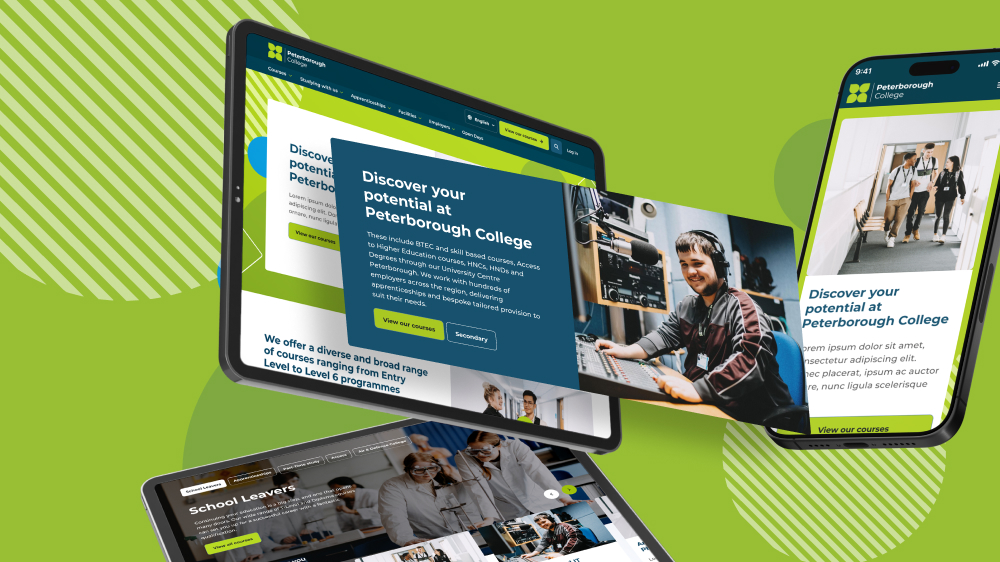
Essential Elements of Further and Higher Education Website Design
Clearly, there’s a lot your education website needs to achieve. So, in order to get it right, you need to ensure the site ticks the following boxes.
Course-Specific Landing Pages
Every course needs its own detailed landing page to provide prospective students with the information they need. These pages should include a clear course overview with entry requirements, fees and duration.
Engaging content such as student testimonials, career prospects and industry links helps make the course more appealing.
Calls to action like ‘Apply Now’, ‘Request a Prospectus’ or ‘Attend an Open Day’ should be prominent to encourage conversions.
SEO-optimised content is also essential, helping the pages rank for searches like ‘Business Management Degree UK’.
Needless to say, these pages need to be easy to find and navigate.
Ecommerce Functionality
Modern education websites must include ecommerce capabilities.
Universities and colleges often need to take online payments for application fees, short courses, professional development enrolments, accommodation deposits and even merchandise or event tickets.
A smooth checkout experience ensures that users can complete transactions easily.
SEO Targeting for Multiple Audiences
A university website must cater to different search intentions.
Prospective students may search for terms like ‘Best engineering courses in London’, while international students will need dedicated pages with visa advice, tuition fees and cultural insights.
Parents and guardians often look for information on financial support and student welfare, while academics and researchers seek research projects and funding opportunities.
Employers and partners also use the website to explore industry collaborations and graduate recruitment services.
Ultimately, getting this right comes down to creating a website that aligns with your target audiences. And to do this, you need to have a deep target audience understanding.
Again, go back to the data insights. Understand your audience behaviours, create detailed audience personas and assess what kind of content they engage with the most and where you might have content gaps in your website.
By structuring content to meet these needs, a website can reach and engage all of its key audiences.
Content to Engage Different Audiences
To keep visitors engaged, a university website must provide tailored content.
Video campus tours and student stories help attract applicants by offering an authentic insight into student life. Alumni success stories build credibility and highlight the value of a degree.
Live chat and chatbots also improve the user experience by offering instant responses to questions.
A well-maintained events page featuring open days, webinars and industry talks keeps prospective and current students informed.
Regularly updated news and blog sections showcase university achievements and thought leadership, boosting both engagement and SEO.
These are just a few examples, but having a content-rich website is key to keeping your audiences engaged and continually providing the value that your target audiences require.
Education websites are never a matter of ‘setting it and forgetting it’ – instead, you need constant content and updates to open up new SEO opportunities, engage your audiences and maximise conversions.
Conversion Rate Optimisation (CRO)
A university website should be designed to guide visitors towards key actions, such as applying or booking an open day.
Sticky CTAs on course pages, such as ‘Start Your Application’, ensure that key actions remain visible as users scroll. Application forms should be as simple as possible – fewer fields lead to higher completion rates.
A/B testing can help refine button colours, CTAs and page layouts to maximise conversions. Exit-intent popups, reminding users to apply or download a prospectus, can help capture interest before they leave the site.
Importantly, CRO is not something you can simply do once when implementing a new website design. It’s an ongoing process that requires research, insights and gradual optimisations. This is why a long-term approach to education website design is so crucial.
Education Website Design Examples
At Itineris, we’ve designed and delivered more higher and further education websites than any other agency in the UK. This means we know what works, and we understand the many different considerations required for different education organisations.
That said, here are a few examples of successful education website design projects we’ve worked on.
Anglia Ruskin University (ARU)
Anglia Ruskin University (ARU) partnered with us to refine the design and UX of their Distance Learning platform, to provide a seamless experience for prospective students worldwide. By optimising landing pages, enhancing navigation and integrating data-driven insights, we created a user journey that maximised engagement and conversions.
The result? A more intuitive platform that helped drive a significant increase in global enrolments while reducing bounce rates by 22%.

Activate Learning Group
Activate Learning Group needed a streamlined digital presence to better serve students while maintaining the unique identity of each college.
We developed a multisite network that unified seven college websites under a single CMS, making management more efficient while enhancing user experience. This helped the group gain a more engaging digital presence that reduced bounce rates by 32%, increased traffic to course pages by 33% and boosted course applications by 11%.
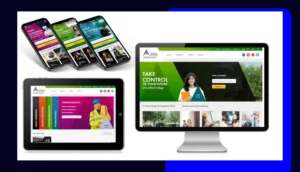
University of Chichester
The University of Chichester partnered with us to refine its digital presence, making course pages more engaging and accessible to prospective students.
By implementing a component-based design system and optimising mobile-friendly user journeys, we created a seamless experience tailored to each course area. This led to a 38% increase in traffic to course pages and a 24% reduction in bounce rates, helping drive more student applications.

University of Westminster
The University of Westminster needed a distinct digital identity for its short courses, separate from its traditional academic offerings.
We designed a bold, engaging website with a clear value proposition, supported by a conversion-focused digital strategy. This new website helped them achieve a 35% drop in bounce rates, a 262% increase in landing page leads and a 122% rise in course applications.
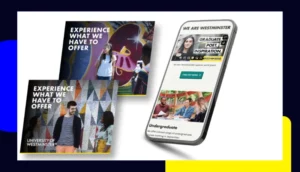
East Kent College Group
EKC Group needed a cohesive digital solution to unify its eight institutions while maintaining their distinct identities. We developed a WordPress Multisite platform, streamlining content management and integrating with Pro-Solution MIS for real-time course updates.
This created a user-friendly, accessible network of sites that improved engagement, simplified enrolment and enhanced the overall student experience.
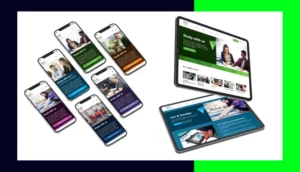
Capel Manor College
Capel Manor College needed a digital strategy that would boost open day bookings and drive student applications. So, our team designed high-converting landing pages and streamlined the user journey. The approach led to a 192% increase in landing page conversions and a 22% drop in bounce rates.
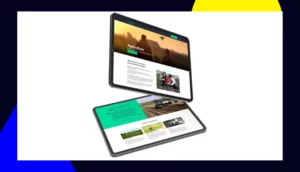
Education Group Website Considerations
Many higher and further education providers act as a group, with multiple college brands and websites underneath the main group.
If not organised and planned strategically, this can pose a challenge for web design.
The best solution is to take a multisite approach – we prefer using WordPress Multisite for projects like this.
This allows you to maintain brand integrity across the entire group while housing distinct websites underneath the main group umbrella.
Each website can be controlled and maintained from the single group dashboard, which makes it a lot easier to maintain a high standard of security, accessibility, compliance and performance optimisation. At the same time, each website is its own, with its own content and branding.
At Itineris, we’ve spearheaded countless WordPress Multisite projects for top college groups. Get in touch to see some of the results we’ve achieved and what we did to achieve award-winning group websites.
Choosing the Right CMS and Hosting Platform for Your Education Website
We briefly mentioned hosting as an element of website security, but we can’t quite emphasise enough just how important your hosting environment is for your education website.
Another major part of this conversion is the Content Management System (CMS) that you choose to power your site.
An education website needs to be scalable, secure and user-friendly. WordPress VIP is a strong choice for universities and education providers, offering high performance, enterprise-level security and the flexibility to support diverse content needs.
It enables institutions to manage course content, publish research and integrate with essential platforms like student portals and CRM systems.
Scalability is another key factor. Education websites often experience traffic spikes during application periods, open days and exam seasons. A slow or unreliable website can frustrate students and impact enrolment.
Beyond the website, your CMS and hosting choice shape your entire digital strategy. A well-optimised site supports SEO, integrates seamlessly with marketing tools and enhances engagement with students, faculty and prospective applicants.
Investing in a powerful CMS and secure hosting solution isn’t just about maintaining a website – it’s about creating a digital hub that strengthens your institution’s reputation and drives student success.
Ensure Your Education Website Design Hits the Mark
The bottom line is this: your education institution has specific needs, and your website needs to serve its unique audience and requirements.
Copying a successful university website design won’t work for your organisation, as you need to address your specific audience, their needs, behaviours and how the website fits into your broader digital presence and strategy.
You need to integrate your website with the right tools. You need to optimise conversions and experiences for your users.
All this requires tailored data insights and research, not a cut and paste approach. That’s where we come in.
At Itineris, we’ve got over 23 years of experience designing impactful education websites for top colleges and universities. Get in touch to see how we can help your organisation achieve the same kind of success we’ve achieved for our clients.

